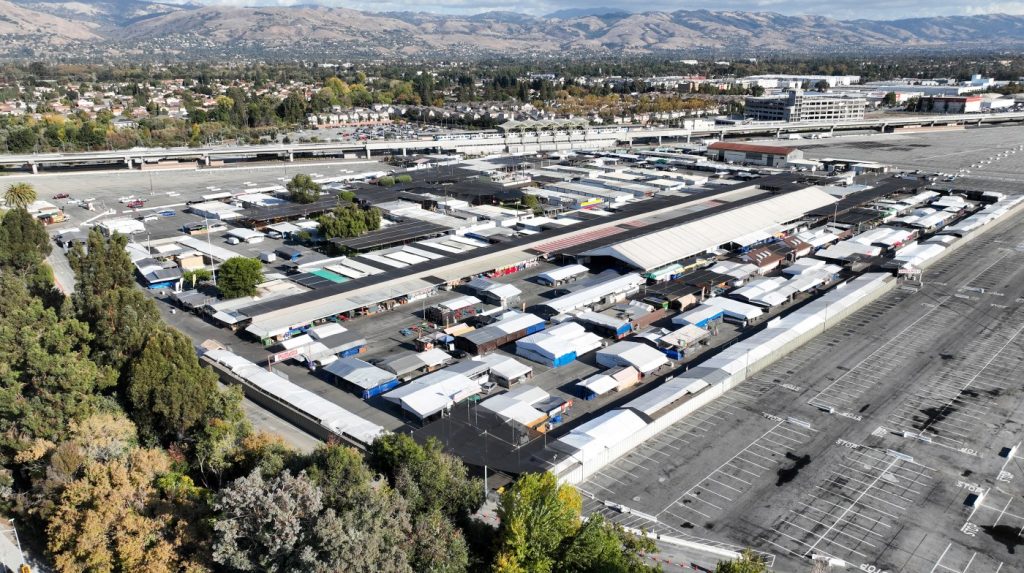San Jose may have just rescued one of its most significant urban development projects — a plan to build thousands of homes at the site of a northside flea market.
Developers had threatened in October to use a legal provision, dubbed the “builder’s remedy,” to significantly scale back plans for a 61-acre ‘urban village’ project at the Berryessa Flea Market, contending high interest rates and increasing construction costs made the original project financially infeasible. They sought to scale back the plan for 2 million square feet of office space and 3,450 housing units — which the city approved in 2021 — to just 940 townhouses.
On Wednesday, Councilmember David Cohen announced a deal with Erik Schoennauer, a land-use consultant representing the site’s property owners, to keep the original plan almost entirely intact. In return for withdrawing its builder’s remedy application, the city will help create a special property tax district to raise $100 million to fund onsite infrastructure improvements. It may also allow the developer to replace some of the office space in the plan with alternative uses, such as an assisted living facility or affordable housing.
“I made it clear from the beginning I was opposed to the builder’s remedy application because it was not in keeping with the longterm vision with the site,” Cohen said in an interview. “I don’t think it’s wise to make a longterm decision on the property based on short term economic conditions.”
Schoennauer, representing a group led by business executives Brian and Thomas Bumb, said: “It’s all we needed to move forward in cooperation with the city.”
The deal will also allow the property owners to avoid a potentially lengthy legal battle over its application of the builder’s remedy, a provision of state law that allows developers to build projects of any size almost anywhere in cities without a state-certified housing plan. The state only approved San Jose’s plan on Jan. 30, leaving the city out of compliance for a year.
Earlier this month, the city decided to fight back against developers, including those behind the Berryessa “urban village,” who had used the builder’s remedy to scale back previously-approved projects. Over 4,000 proposed units — including 2,500 at the Berryessa BART Urban Village — were at risk of nondevelopment. They argued that the builder’s remedy, meant to compel cities to meet their housing production goals, can only apply when scaling up a project.
With the Berryessa development group acquiescing, that argument goes unchallenged for now.
“We’ve decided it makes more sense to work with the city to make something happen,” Schoennauer said.
That’s welcome news to one of the project’s biggest advocates — Mayor Matt Mahan.
“I was glad to see the property owner drop their Builder’s Remedy application, which would have significantly downsized housing and job capacity next to one of the most important public transit investments we’ve made in decades,” the mayor said in a statement. “I stand ready to work with them to secure infrastructure financing and get this project underway.”
Related Articles
Newsom promised San Jose 200 tiny homes for the homeless. Now he’s pulling back
Editorial: Elect Nguyen, Abe-Koga to Santa Clara County board
San Jose to fight developers using ‘builder’s remedy’ to downsize housing projects
Letters: Historic neighborhoods | Customer service | Trump years | Misdeeds piling up | No money | War-first stance
‘One of our great residents’: San Jose community leader Frank Fiscalini dies at 101
This proposed special tax district, a Community Facility District, can issue bonds to pay for on-site infrastructure improvements upfront, which are then repaid over time with a property tax applied only to parcels within the district. Schoennhauer expects to raise $100 million through such a district to pay for improvements, including additional streets and sidewalks, sewer line extensions and two bridges over Coyote Creek.
Schoennhauer indicated that, before submitting the builder’s remedy application, the city had dragged its feet on initiating the process to establish a community facility district, but said that Councilman Cohen’s assurances made him optimistic that the district would be created in the next 18 months.
The developer signed an agreement to allow the flea market to continue operating until Jan. 1, 2026, with the project breaking ground after that.


